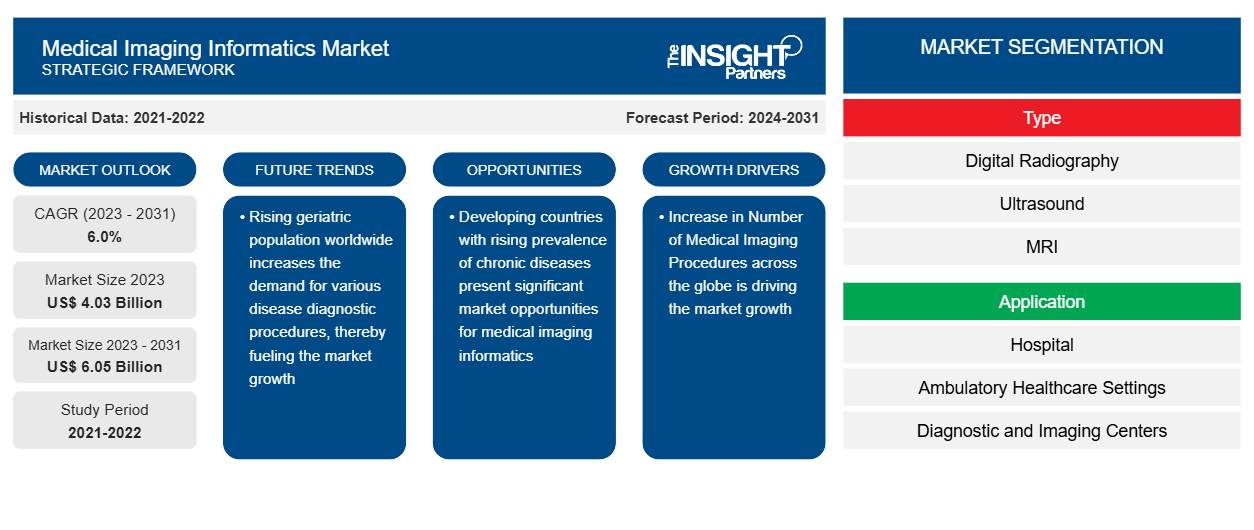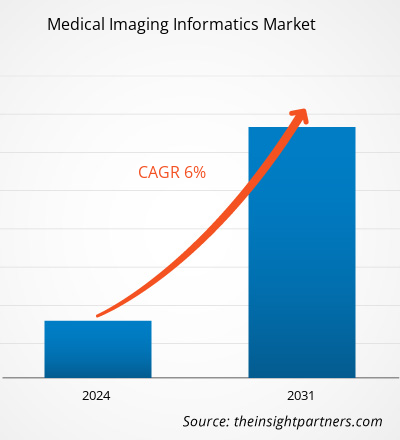The medical imaging informatics market size is projected to reach US$ 6.05 billion by 2031 from US$ 4.03 billion in 2023. The market is expected to register a CAGR of 6.0% during 2023–2031. Rising demand for AI- and cloud-based platforms will likely remain a key trend in the market.
Medical Imaging Informatics Market Analysis
Key factors driving the market growth are the increasing number of medical imaging procedures and the surge in the geriatric population. Furthermore, technological advancements in medical imaging informatics have created growth opportunities for the market over the upcoming forecast period.
Medical Imaging Informatics Market Overview
According to the clinical search engine Radiology Key, imaging informatics involves using information technology (IT) to deliver efficient, accurate, and reliable medical imaging services within a healthcare network. Also referred to as radiology informatics, medical imaging informatics is responsible for storing, managing, and accessing image-related information and data. Medical imaging is broadly used in cardiology, obstetrics, surgery, and gynecology applications, among others, in the healthcare sector. In addition to the rise in diagnoses, a growing emphasis of regional and national governments on early diagnosis of medical conditions to lower overall healthcare costs is driving the number of patients undergoing magnetic resonance imaging (MRI), computed tomography (CT), ultrasound, and X-ray scans worldwide, thereby bolstering the need for medical imaging informatics.
Customize This Report To Suit Your Requirement
You will get customization on any report - free of charge - including parts of this report, or country-level analysis, Excel Data pack, as well as avail great offers and discounts for start-ups & universities
Medical Imaging Informatics Market: Strategic Insights

-
Get Top Key Market Trends of this report.This FREE sample will include data analysis, ranging from market trends to estimates and forecasts.
Medical Imaging Informatics Market Drivers and Opportunities
Surge in Geriatric Population
The UK, Canada, Japan, China, India, and South Korea, among other economies, have considerably modernized healthcare facilities and services. As a result, the life expectancy of people in these countries has increased, leading to the growth in their geriatric population base. According to data from the WHO, in 2019, the number of people aged 60 years and older was 1 billion, likely to rise to 1.4 billion by 2030 and 2.1 billion by 2050. The elderly population majorly suffers from various chronic diseases, such as cardiovascular diseases (CVD), due to structural and functional changes in their cardiovascular systems associated with aging. Aging leads to the stiffening of the heart and blood vessels. Thus, arrhythmias, as well as coronary artery disease and heart failure, are common risk factors in people aged 75 and above. In the 2019 Heart Disease and Stroke statistical update by the American Heart Association (AAH), the incidence of CVDs was 77.2% in males and 78.2% in females from the age group of 60–79 years. Furthermore, the incidence of CVDs was 89.3% in adult males and 91.8% in adult females of age 80 and above. Thus, the rising geriatric population worldwide increases the demand for various disease diagnosis procedures and medical imaging informatics, fueling market growth.
Dynamic Healthcare Landscapes in China and India
Developing countries such as China and India present significant market opportunities for medical imaging informatics. With growing populations, increasing healthcare expenditures, and a rising prevalence of chronic diseases, there is a growing demand for advanced medical imaging technologies in these countries. The adoption of digital imaging systems and informatics solutions is rising in China and India, driven by the need for efficient data management, improved diagnostic accuracy, and enhanced patient care. In China, the government's initiatives to modernize healthcare infrastructure and improve access to quality healthcare services have led to an increased adoption of medical imaging informatics solutions. The country's large population and expanding healthcare sector provide a vast market for vendors offering advanced imaging informatics technologies. In India, the growing number of healthcare facilities, coupled with the rising awareness of the benefits of digital imaging, is driving the demand for informatics solutions that can streamline workflows and enhance clinical decision-making. By leveraging these opportunities and addressing the specific needs of these markets, vendors can tap into the tremendous growth potential offered by these developing countries.
Medical Imaging Informatics Market Report Segmentation Analysis
Key segments that contributed to the derivation of the medical imaging informatics market analysis are product and end user.
- Based on type, the medical imaging informatics market is digital radiography, ultrasound, MRI, CT, nuclear imaging, mammography. The ultrasound segment held a largest market share in 2023.
- Based on application, the medical imaging informatics market is segmented by hospital, ambulatory healthcare settings, diagnostic and imaging centers, others. The hospitals segment held a largest market share in 2023.
- Based on component, the medical imaging informatics market is segmented by software, hardware, services. The software segment held a largest market share in 2023.
Medical Imaging Informatics Market Share Analysis by Geography
The geographic scope of the medical imaging informatics market report is mainly divided into five regions: North America, Asia Pacific, Europe, Middle East & Africa, and South & Central America.
In North America, the US is the largest market for medical imaging informatics. The US medical imaging informatics market is expected to grow significantly due to the increasing prevalence of cancer, rising demand for diagnostic imaging, and growing geriatric population across the country. Moreover, various developments done by leading market players in the country and increased government investment to promote the medical device industry are also expected to fuel market growth during the forecast period.
In the United States and around the world, cancer has a significant impact on society. Cancer statistics show what occurs in big groups of people and provide a snapshot of the disease's impact on society across time. According to Globocan 2020, the US had 2,281,658 new cancer cases, which accounted for 612,390 deaths. The most common types of cancer in the country are breast cancer, lung cancer, prostate cancer, colorectum cancer, and others. Thus, the rising prevalence of cancer in the country is expected to fuel the demand for medical imaging tools such as ultrasound, MRI, digital and computed radiography, etc. The demand for medical information informatics will also flourish during the forecast period.
Medical Imaging Informatics Market Regional Insights
The regional trends and factors influencing the Medical Imaging Informatics Market throughout the forecast period have been thoroughly explained by the analysts at The Insight Partners. This section also discusses Medical Imaging Informatics Market segments and geography across North America, Europe, Asia Pacific, Middle East and Africa, and South and Central America.
Medical Imaging Informatics Market Report Scope
| Report Attribute | Details |
|---|---|
| Market size in 2023 | US$ 4.03 Billion |
| Market Size by 2031 | US$ 6.05 Billion |
| Global CAGR (2023 - 2031) | 6.0% |
| Historical Data | 2021-2022 |
| Forecast period | 2024-2031 |
| Segments Covered |
By Type
|
| Regions and Countries Covered |
North America
|
| Market leaders and key company profiles |
|
Medical Imaging Informatics Market Players Density: Understanding Its Impact on Business Dynamics
The Medical Imaging Informatics Market is growing rapidly, driven by increasing end-user demand due to factors such as evolving consumer preferences, technological advancements, and greater awareness of the product's benefits. As demand rises, businesses are expanding their offerings, innovating to meet consumer needs, and capitalizing on emerging trends, which further fuels market growth.

- Get the Medical Imaging Informatics Market top key players overview
Medical Imaging Informatics Market News and Recent Developments
The Medical Imaging Informatics Market is evaluated by gathering qualitative and quantitative data post primary and secondary research, which includes important corporate publications, association data, and databases. A few of the developments in the medical imaging informatics market are listed below:
- Philips debuts new AI-enhanced informatics solutions to increase diagnostic confidence with intelligence at every step of the radiology workflow at RSNA (Source: Philips, Company Website, November 2022)
Medical Imaging Informatics Market Report Coverage and Deliverables
The “Medical Imaging Informatics Market Size and Forecast (2021–2031)” report provides a detailed analysis of the market covering below areas:
- Medical imaging informatics market size and forecast at global, regional, and country levels for all the key market segments covered under the scope
- Medical imaging informatics market trends as well as market dynamics such as drivers, restraints, and key opportunities
- Detailed PEST/Porter’s Five Forces and SWOT analysis
- Medical imaging informatics market analysis covering key market trends, global and regional framework, major players, regulations, and recent market developments.
- Industry landscape and competition analysis covering market concentration, heat map analysis, prominent players, and recent developments for the medical imaging informatics market
- Detailed company profiles
Frequently Asked Questions
Which region dominated the medical imaging informatics market in 2023?
What are the driving factors impacting the teleradiology services market?
What are the future trends of the teleradiology services market?
Which are the leading players operating in the medical imaging informatics market?
What is the expected CAGR of the medical imaging informatics market?
- Historical Analysis (2 Years), Base Year, Forecast (7 Years) with CAGR
- PEST and SWOT Analysis
- Market Size Value / Volume - Global, Regional, Country
- Industry and Competitive Landscape
- Excel Dataset
Recent Reports
Related Reports
Testimonials
Reason to Buy
- Informed Decision-Making
- Understanding Market Dynamics
- Competitive Analysis
- Identifying Emerging Markets
- Customer Insights
- Market Forecasts
- Risk Mitigation
- Boosting Operational Efficiency
- Strategic Planning
- Investment Justification
- Tracking Industry Innovations
- Aligning with Regulatory Trends





















 Get Free Sample For
Get Free Sample For